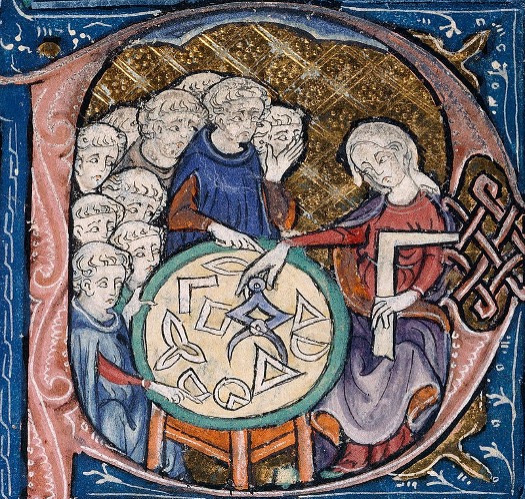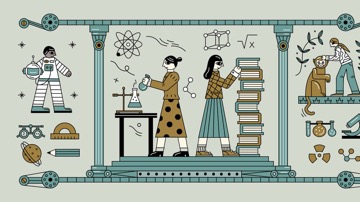“…For it is the fate of a woman
Long to be patient and silent, to wait like a ghost that is speechless,
Till some questioning voice dissolves the spell of its silence.
Hence is the inner life of so many suffering women
Sunless and silent and deep, like subterranean rivers
Running through caverns of darkness…”
― Henry Wadsworth Longfellow.
Many women find themselves squeezed out of awards ceremonies — and not just when it’s a Nobel Prize. From physicist Lise Meitner to biologist Rosalind Franklin to astronomer Jocelyn Bell, many of these scientists did not gain the recognition they deserved until years after their discoveries. The minimisation, if not denial, of the contribution of women scientists to research is not a new phenomenon. The science historian Margaret Rossiter theorised it as the Matilda effect.
In the 1960s, the sociologist Robert King Merton, became interested in the way in which certain great figures are recognised to the detriment of their relatives, who often participated in the work that gave rise to this fame. He then developed a theory on the inequitable way in which the glory is shared, which he calls “the Matthew effect”, in reference to a verse of the gospel according to Matthew 13 :12: “For to him who has, will be given, and he will have plenty, but from him who has not, even what he has will be taken away.”
In the early 1980s, Margaret Rossiter took up the concept and pushed it further. She notes that the Matthew effect is multiplied when it is applied to women scientists. She therefore deepens the sociological research, and names the result of her own efforts the “Matilda Effect” in tribute to the feminist activist Matilda Joslyn Gage who, from the end of the 19th century, had noticed that a minority of men tended to monopolize the intellectual thoughts of women.
Beginning in the 1960s, when the women’s movement in the 20th century was nearing its peak, women campaigned for, and finally won equal rights in education and employment. The increasing availability of effective birth-control methods meant that women could plan their families along with their futures, and the dual-career family became the norm rather than the exception. These social changes, which affected women in all walks of life, had a major impact on their participation in higher education. Instead of a few women training to be teachers or nurses, female students in increasing numbers were now choosing careers in physics, chemistry, and mathematics, as well as in law and business.
And yet, according to data from the UNESCO Institute of Statistics (UIS), less than 30% of the world’s researchers are women. UIS data also show the extent to which these women work in the public, private or academic sectors, as well as their fields of research. But to truly reduce the gender gap, we must go beyond the hard numbers and identify the qualitative factors that deter women from pursuing careers in science, technology, engineering and mathematics (STEM).
The role of women in the scientific field was and still is essential, despite the marginalisation and belittling of women throughout history. Where she was treated with inferiority, due to the dominance of the male mentality or the so-called patriarchy.
Derived from the history of Athenian society, the greatest Greek philosophers, especially Plato and Aristotle, entrenched the idea that women are a profane being, and this thought has prevailed for centuries.
Where Socrates said that women give birth to bodies, while philosophers give birth to souls, here it appears that the task of women is limited only to procreation and food preparation. Plato also considered that a man is a perfect being and what he can strive for is absolute perfection. As for a woman, she can only strive to be a man. This is the highest that a woman can achieve.
Aristotle considered woman in his hylomorphism philosophy as a deficient being in terms of matter because she does not contain sperms that contain the entire human being, but a man can do that because when he has sexual intercourse with a woman, he gives her the essence of the soul, “ the sperm”, while she gives him the egg that guarantees nourishment, and that is what the woman does in her daily life. That is why Greek philosophers have always considered women as an infertile men.
Despite the misogynistic philosophy of Plato and Aristotle, Hypatia (born c. 355 CE—died March 415, Alexandria) the daughter of Theon of Alexandria (c. 335–405 CE) was influenced by the Platonic trend and was appointed dean of the Platonic school around 400 AD.
Hypatia, on the other hand, led the life of a respected academic at Alexandria’s university; a position to which only males were entitled previously. She surpassed her well-respected father as evidenced by ancient testimonies to her brilliance. She never married and remained celibate throughout her life, devoting herself to learning and teaching. The ancient writers are in agreement that she was a woman of enormous intellectual power, even the Christian writers who were hostile toward her, such as John of Nikiu. [1]
There are many female scientists who have contributed greatly to the development of science throughout history. I will mention some of them.
Lise Meitner (1968-1878):
(born November 7, 1878, Vienna, Austria-Hungary [now in Austria]—died October 27, 1968, Cambridge, Cambridgeshire, England), Austrian-born physicist who shared the Enrico Fermi Award (1966) with the chemists Otto Hahn and Fritz Strassmann for their joint research that led to the discovery of uranium fission. She was a professor of physics in Germany, but she lost the position due to the institution of anti-Jewish race laws under the Nazi regime. She then fled to Sweden where she lived for several years and became a citizen.
Mileva Marić (1948-1875) :
Albert Einstein’s wife, Mileva, she was a great help to him in his younger years when the physicist published his first papers. Fallen into oblivion, she suffered like other women. She was a scientist and researcher in mathematics and physics and was able to enter among those registered for the course of teaching a diploma in physics and mathematics at the Polytechnic Institute in Zurich (now ETH) in 1896 with four other students: Marcel Grossmann, Louis Kollros, Jakob Ehrat and Albert Einstein, and she was the only woman in the group.
It is thanks to the letters exchanged between Albert Einstein and his wife Mileva, that the scientific community began to question the importance of the latter in the establishment of the theory of relativity. On March 27, 1901, the scholar wrote to him as follows:
How happy and proud I will be when we both together lead our work on the relative movement to a successful conclusion!
If these questions do not detract from the genius of Albert Einstein, the stake of the debate is to know to what extent the physicist participated in the discovery of the theory of general relativity.
When Albert Einstein gave his first lessons in Zurich in 1909, the first pages of his lessons were written by the hand of Mileva Einstein, relates Pauline Gagnon. More and more recognized, the physicist leaves his wife the care of educating their children.
Mileva Marić died in 1948, at the age of 72, without ever having claimed the status of collaborator with Albert Einstein or asked for public recognition.
In the world of science historians, Mileva Marić’s story is debated. The letters that she and Albert Einstein wrote to each other, the testimonies collected by certain biographers, tend to show that Mileva Marić indeed helped the most famous of physicists to reflect on his first theories and to publish his first papers. But at what point? Did she help him until 1901, or even later, and in particular during Einstein’s Annus Mirabilis, in 1905, when the latter published no less than four articles establishing the bases of modern physics? (And in particular its equation E = MC²). Their second son, Hans Albert, thus confided to the biographer of Mileva Marić that “the scientific collaboration of his parents continued after their marriage and that he remembered seeing them working together in the evening at the same table”.

Alice Ball (1916-1892) :
An American chemist, she developed a treatment for leprosy despite the tragic shortness of her career. She is the first female and first African American to graduate from the University of Hawaiʻi. [2]
At the University of Hawaiʻi, Alice Ball worked with Dr. Harry T. Hollmann on the properties of Chaulmoogra oil, used in the treatment of leprosy. At the time, leprosy patients were sent to the Hawaiian island of Molokai, and treated with Chaulmoogra oil. The remedy has a severe flaw: “thick and sticky”, the oil is ineffective when applied externally and painful when injected, forming blisters under the skin. And its pungent taste, making patients vomit, prevents it from being used by ingestion.
Just 23 years old, Alice developed a technique to isolate the ethyl ester of fatty acids from Chaulmoogra oil and make it soluble in water. Known as “the Ball Method,” this process makes the remedy injectable and prevents problems with ingestion or blisters forming under the skin.
Despite the tragic fate of women scientists throughout history, our world today is witnessing a significant development in the intense participation of women in science.
Hedwig Eva Maria Kiesler “Hedy Lamarr” (1914-2000):
She was an artist and mathematician. After a career in technical research with her father, who was a bank director and curious man, he inspired her to look at the world with scientific eyes. He would often take her for long walks where he would discuss the inner workings of different machines, like the printing press and street cars. Together with the pianist George Antheil, she applied for a patent on the design of a highly impenetrable wireless communication system. Lamarr and Antheil sought a patent and military support for the invention. While awarded U.S. Patent No. 2,292,387 in August of 1942, the Navy decided against the implementation of the new system. The system involved the use of “frequency hopping” amongst radio waves, with both transmitter and receiver hopping to new frequencies together. Doing so prevented the interception of the radio waves, thereby allowing the torpedo to find its intended target. [3]
And in 1962, the idea of Hedy and George was used in the Bay of Pigs episode in Cuba. The invention was finally recognized, but it was not until 1997 that the United States thanked Hedy Lamarr for her work.
Too late for Hedy, who has lived all her life with the suffering of not being recognized for her genius, she will end up alcoholic and pickpocket before dying in 2000, in relative anonymity.
HODGKIN DOROTHY MARY CROWFOOT (1910-1994):
British biochemist born in Cairo (Egypt), died in Ilmington (Warwickshire). Dorothy Mary Crowfoot Hodgkin began her studies in chemistry in Oxford in 1928 and continued in 1932 in Cambridge, where she was introduced, under the supervision of John Desmond Bernal, to the determination of crystal structures by X-ray diffraction. [4]
The subject of Hodgkin’s research was the determination by X-ray diffraction of the three-dimensional structure of complex and biologically important molecules. Among all the results to her works, the three most important are undoubtedly those relating to penicillin (1949), vitamin B12 (1957) and insulin (1969).
Despite the tragic fate of women scientists throughout history, our world today is witnessing a significant development in the intense participation of women in science.
[1] Dzielska, M. Hypatia of Alexandria. Harvard University Press, 1996.
[2] Jackson, Miles (2004). “African Americans in Hawai’i”. Social Process in.
[3] Positively Poisonous, Medusa’s Heroin, Beauty and Brains”. Dark Matters: Twisted But True. September 7, 2011
[4] Encyclopaedia Britannica, Dorothy Crowfoot Hodgkin.

